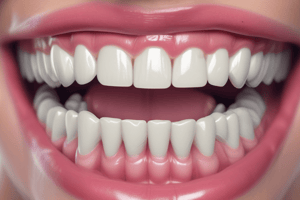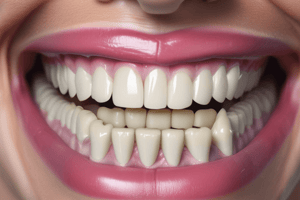Podcast
Questions and Answers
What is the primary composition of the pellicle that forms on tooth surfaces?
What is the primary composition of the pellicle that forms on tooth surfaces?
- Glycoproteins (correct)
- Polysaccharides and lipids
- Proteins and enzymes
- Calcium and phosphate
Which of the following correctly describes the thickness of a pellicle?
Which of the following correctly describes the thickness of a pellicle?
- 0.1 - 0.8 nm (correct)
- 1.0 - 2.0 nm
- 0.1 - 0.5 nm
- 0.5 - 1.0 nm
What is one of the main functions of the pellicle in oral health?
What is one of the main functions of the pellicle in oral health?
- Providing a barrier against acids (correct)
- Accelerating plaque formation
- Enhancing tooth sensitivity
- Decreasing saliva production
Which type of pellicle is primarily formed from saliva?
Which type of pellicle is primarily formed from saliva?
What is the appearance of materia alba when found in the oral cavity?
What is the appearance of materia alba when found in the oral cavity?
What process assists in the formation of a pellicle on the tooth surface?
What process assists in the formation of a pellicle on the tooth surface?
What role does the pellicle play in bacterial activity in the oral cavity?
What role does the pellicle play in bacterial activity in the oral cavity?
Which of the following characteristics is NOT true of the pellet formation?
Which of the following characteristics is NOT true of the pellet formation?
What is the primary component of supragingival plaque?
What is the primary component of supragingival plaque?
Which stage of plaque adherence is characterized by a firmer adhesion to the tooth surface?
Which stage of plaque adherence is characterized by a firmer adhesion to the tooth surface?
Which type of calculus can be described as developing below the gingival margin?
Which type of calculus can be described as developing below the gingival margin?
What is the typical timeframe for plaque to fully mineralize into calculus?
What is the typical timeframe for plaque to fully mineralize into calculus?
What role does saliva play in oral hygiene?
What role does saliva play in oral hygiene?
What is the characteristic appearance of supragingival calculus?
What is the characteristic appearance of supragingival calculus?
Which factor can contribute to the rapid formation of plaque?
Which factor can contribute to the rapid formation of plaque?
Which type of plaque is referred to as 'pit and fissure plaque'?
Which type of plaque is referred to as 'pit and fissure plaque'?
What primarily composes the mineralization of calculus?
What primarily composes the mineralization of calculus?
Which of the following best describes the potential hazards of poorly managed plaque?
Which of the following best describes the potential hazards of poorly managed plaque?
Flashcards are hidden until you start studying
Study Notes
Characteristics of Pellicle
- Translucent, thin, amorphous, acellular organic film; tenacious membranous layer.
- Adheres to teeth, restorations, calculus, and other firm surfaces in the oral cavity.
- Thickness ranges from 0.1 to 0.8 nm; stains positive for sugars and proteins but does not bind dyes.
Formation and Composition
- Forms within minutes after removal of external materials, primarily composed of glycoproteins absorbed by hydroxyapatite on the tooth surface.
- Notable accumulation around the gingival margin.
Pellicle Types
- Subsurface Pellicle: Continuous with tooth structure.
- Surface Pellicle:
- Unstained: Lingual, buccal, palatal surfaces.
- Stained: Visible to the naked eye.
- Supragingival pellicle originates from saliva; subgingival pellicle from gingival crevicular fluid (GCF).
Functions of the Pellicle
- Protective: Acts as a barrier against acids, potentially reducing dental caries.
- Lubrication: Maintains moisture on tooth surfaces.
- Nidus for Bacteria: Facilitates plaque formation and microbial adherence.
- Attachment of Calculus: Involved in calculus formation on tooth surfaces.
Characteristics of Materia Alba
- Informal accumulation, appearing as loosely adherent, unstructured white or grayish-white masses of oral debris and bacteria.
- Resembles cottage cheese; high bacterial count and can be removed with vigorous rinsing or irrigation.
Clinical Implications
- Materia alba collection occurs in open contact areas, mobile teeth, and occlusal irregularities.
- Associated with gingival inflammation, tooth surface demineralization, and dental caries.
Prevention Strategies
- Self-cleansing mechanisms via tongue, saliva, and lips.
- Regular tooth brushing and flossing are vital.
Role in Periodontal Disease
- Periodontal disease is an aetiological factor characterized by organized bacterial systems within an intermicrobial matrix.
- Comprised of dense bacterial arrays that adhere loosely to teeth and calculus deposits, with significant species variety (500-700 species per gram of plaque).
Types of Plaque
- Supragingival Plaque: White or yellowish layer along the gingival margin; rapidly increases in volume.
- Subgingival Plaque: Less visible clinically, located below the gingival margin and observed through staining.
Stages of Plaque Development
- Reversible Stage: Loosely adheres to teeth via hydrogen bonds and electrostatic attraction.
- Irreversible Stage: Firmer adhesion of bacteria to the acquired pellicle and calculus.
Nutritional Needs for Microbial Growth
- Bacteria require carbohydrates from foods, particularly sugars, for growth and plaque formation.
- The dietary fibrous components also contribute to plaque development.
Calculus Formation
- Composed of 70-80% inorganic salts, with 15-20% organic compounds (calcium, magnesium, fluoride).
- Mineralization process takes 24-48 hours, fully mineralizing in 10-20 days.
Supragingival vs. Subgingival Calculus
- Supragingival Calculus: Yellow/white appearance, accumulates in areas of salivary ducts, usually more visible.
- Subgingival Calculus: Darker with age, localized or generalized throughout the mouth, commonly forms below the gingival margin.
Attachment Mechanisms
- Initial attachment leads to growth and organization; mineralization adheres firmly to tooth surfaces.
- Tenacious attachment occurs due to calcification of the underlying pellicle and surface irregularities.
Health Considerations
- Poor oral hygiene and lack of adequate care lead to plaque accumulation and subsequent periodontal disease.
- Rough tooth surfaces and personal plaque control measures play significant roles in oral health maintenance.
Studying That Suits You
Use AI to generate personalized quizzes and flashcards to suit your learning preferences.




